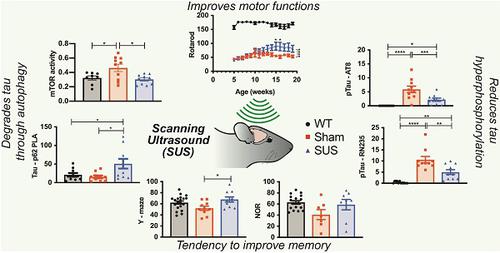当前位置:
X-MOL 学术
›
Theranostics
›
论文详情
Our official English website, www.x-mol.net, welcomes your
feedback! (Note: you will need to create a separate account there.)
Repeated ultrasound treatment of tau transgenic mice clears neuronal tau by autophagy and improves behavioral functions.
Theranostics ( IF 12.4 ) Pub Date : 2019-01-01 , DOI: 10.7150/thno.34388 Rucha Pandit 1 , Gerhard Leinenga 1 , Jürgen Götz 1
Theranostics ( IF 12.4 ) Pub Date : 2019-01-01 , DOI: 10.7150/thno.34388 Rucha Pandit 1 , Gerhard Leinenga 1 , Jürgen Götz 1
Affiliation

|
Intracellular deposits of pathological tau are the hallmark of a broad spectrum of neurodegenerative disorders collectively known as tauopathies, with Alzheimer's disease, a secondary tauopathy, being further characterized by extracellular amyloid plaques. A major obstacle in developing effective treatments for tauopathies is the presence of the blood-brain barrier, which restricts the access of therapeutic agents to the brain. An emerging technology to overcome this limitation is the application of low-intensity ultrasound which, together with intravenously injected microbubbles, transiently opens the blood-brain barrier, thereby facilitating the delivery of therapeutic agents into the brain. Interestingly, even in the absence of therapeutic agents, ultrasound has previously been shown to reduce amyloid plaques and improve cognitive functions in amyloid-depositing mice through microglial clearance. Ultrasound has also been shown to facilitate the delivery of antibody fragments against pathological tau in P301L tau transgenic mice; however, the effect of ultrasound alone has not been thoroughly investigated in a tauopathy mouse model. Methods: Here, we performed repeated scanning ultrasound treatments over a period of 15 weeks in K369I tau transgenic mice with an early-onset tau-related motor and memory phenotype. We used immunohistochemical and biochemical methods to analyze the effect of ultrasound on the mice and determine the underlying mechanism of action, together with an analysis of their motor and memory functions following repeated ultrasound treatments. Results: Repeated ultrasound treatments significantly reduced tau pathology in the absence of histological damage. Associated impaired motor functions showed improvement towards the end of the treatment regime, with memory functions showing a trend towards improvement. In assessing potential clearance mechanisms, we ruled out a role for ubiquitination of tau, a prerequisite for proteasomal clearance. However, the treatment regime induced the autophagy pathway in neurons as reflected by an increase in the autophagosome membrane marker LC3II and a reduction in the autophagic flux marker p62, along with a decrease of mTOR activity and an increase in beclin 1 levels. Moreover, there was a significant increase in the interaction of tau and p62 in the ultrasound-treated mice, suggesting removal of tau by autophagosomes. Conclusions: Our findings indicate that a neuronal protein aggregate clearance mechanism induced by ultrasound-mediated blood-brain barrier opening operates for tau, further supporting the potential of low-intensity ultrasound to treat neurodegenerative disorders.
中文翻译:

重复超声处理tau转基因小鼠通过自噬清除神经元tau并改善行为功能。
病理性tau的细胞内沉积物是广谱的神经退行性疾病的标志,这些疾病统称为tauopathies,继发性tauopathy的阿尔茨海默氏病,其特征还在于细胞外淀粉样斑块。研发有效的刀伤疗法的主要障碍是血脑屏障的存在,它限制了治疗剂进入大脑的能力。克服这一局限性的一项新兴技术是低强度超声的应用,该技术与静脉注射的微气泡一起可暂时打开血脑屏障,从而促进治疗剂向大脑的输送。有趣的是,即使没有治疗剂,超声波先前已显示可通过小胶质细胞清除减少淀粉样蛋白斑块并改善淀粉样蛋白沉积小鼠的认知功能。在P301L tau转基因小鼠中,超声也被证明可以促进针对病理性tau的抗体片段的输送。但是,尚未在tauopathy小鼠模型中彻底研究仅超声的作用。方法:在这里,我们在具有早发性tau相关运动和记忆表型的K369I tau转基因小鼠中进行了为期15周的重复扫描超声治疗。我们使用免疫组化和生化方法来分析超声对小鼠的影响,并确定其潜在的作用机制,并分析其在反复超声治疗后的运动和记忆功能。结果:在没有组织学损伤的情况下,重复的超声治疗可显着降低tau病理。伴随运动功能受损的患者在治疗方案结束时表现出改善,而记忆功能表现出改善的趋势。在评估潜在的清除机制时,我们排除了tau泛素化(蛋白酶体清除的先决条件)的作用。然而,该治疗方案在神经元中诱导了自噬途径,这反映在自噬体膜标记物LC3II的增加和自噬通量标记物p62的减少,以及mTOR活性的下降和Beclin 1水平的提高。此外,在超声处理的小鼠中,tau和p62的相互作用显着增加,表明自噬体去除了tau。结论:
更新日期:2019-01-01
中文翻译:

重复超声处理tau转基因小鼠通过自噬清除神经元tau并改善行为功能。
病理性tau的细胞内沉积物是广谱的神经退行性疾病的标志,这些疾病统称为tauopathies,继发性tauopathy的阿尔茨海默氏病,其特征还在于细胞外淀粉样斑块。研发有效的刀伤疗法的主要障碍是血脑屏障的存在,它限制了治疗剂进入大脑的能力。克服这一局限性的一项新兴技术是低强度超声的应用,该技术与静脉注射的微气泡一起可暂时打开血脑屏障,从而促进治疗剂向大脑的输送。有趣的是,即使没有治疗剂,超声波先前已显示可通过小胶质细胞清除减少淀粉样蛋白斑块并改善淀粉样蛋白沉积小鼠的认知功能。在P301L tau转基因小鼠中,超声也被证明可以促进针对病理性tau的抗体片段的输送。但是,尚未在tauopathy小鼠模型中彻底研究仅超声的作用。方法:在这里,我们在具有早发性tau相关运动和记忆表型的K369I tau转基因小鼠中进行了为期15周的重复扫描超声治疗。我们使用免疫组化和生化方法来分析超声对小鼠的影响,并确定其潜在的作用机制,并分析其在反复超声治疗后的运动和记忆功能。结果:在没有组织学损伤的情况下,重复的超声治疗可显着降低tau病理。伴随运动功能受损的患者在治疗方案结束时表现出改善,而记忆功能表现出改善的趋势。在评估潜在的清除机制时,我们排除了tau泛素化(蛋白酶体清除的先决条件)的作用。然而,该治疗方案在神经元中诱导了自噬途径,这反映在自噬体膜标记物LC3II的增加和自噬通量标记物p62的减少,以及mTOR活性的下降和Beclin 1水平的提高。此外,在超声处理的小鼠中,tau和p62的相互作用显着增加,表明自噬体去除了tau。结论:










































 京公网安备 11010802027423号
京公网安备 11010802027423号